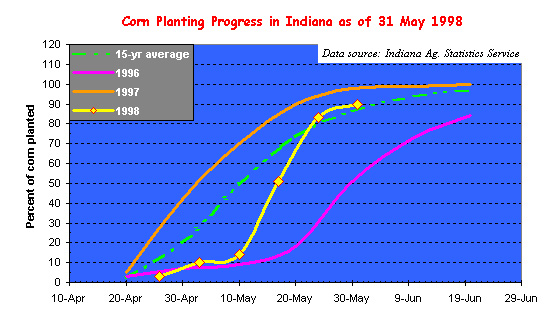
A few short weeks ago, corn farmers all over the state were singing the blues about the late start to planting the 1998 corn crop. In fact, until the 10th of May, Indiana's corn planting progress was about the slowest in recent memory (see Fig. 1 below).
However, during the two week period that followed, nearly 70 percent of the state's corn crop was planted. That nearly linear rate of planting progress translates to about 5 percent of the state's crop planted per day! Such a rate of planting progress surpasses that of planting period in 1997 when planting was completed by a record early date.
The planting capacity of today's modern machinery is truly a-maize-ing and is the reason why late starts to a planting season no longer automatically spell disaster. Barring unusually lengthy periods of rainy weather, Corn Belt farmers can "catch up" extremely fast.
The unfortunate side to this story is that, although 90 percent of the state's corn crop was in the ground as of May 31 (Indiana Weekly Weather & Crops, Vol. 48, #9), only 69 percent of the intended corn planting was complete across the southern third of the state because of continued rains and saturated, if not flooded, soils. While the length of the remaining growing season will still accomodate corn planting through mid- to late June in this area of Indiana, farmers will need to balance the effects on net income of reduced yields and wetter grain due to delayed planting of corn with the potential net income from switching to another crop such as soybean.